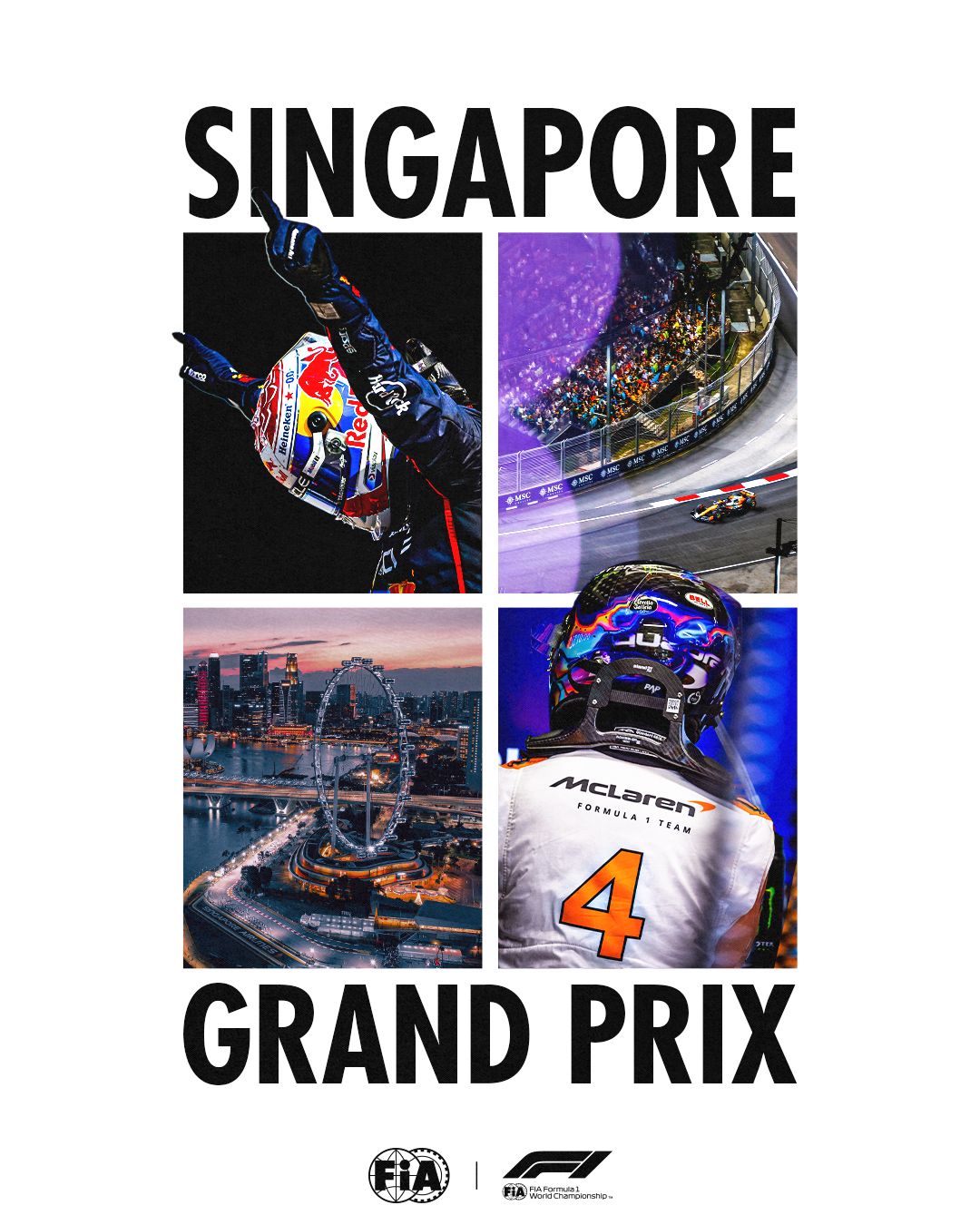
[Source](https://x.com/fia/status/1972659169430851996/photo/1)
Luego de una semana de descanso desde la cita de Azerbaiyán, vuelve la acción a la Fórmula Uno, esta vez en el joven Marina Bay Street Circuit para dar cumplimiento a la fecha número 18 del calendario anual, el Gran Premio de Singapur.
Escribí joven circuito porque simplemente es así, fue inaugurado en 2008, muy poco tiempo si lo comparamos con los más antiguos aunque remozados circuitos, que representan la historia y tradición de estas competencias donde se vienen desarrollando desde sus inicios los campeonatos de esta que es la categoría madre del automovilismo.
Desde su inclusión en el calendario anual, no ha sido sencillo el camino para el circuito de Marina Bay; la decisión de que la carrera se corriera en horario nocturno trajo aparejadas no pocas polémicas y entredichos. Los constructores y pilotos pusieron grandes reparos apelando a la inseguridad, aunque la FIA se mantuvo en su decisión y las carreras nocturnas dieron comienzo.
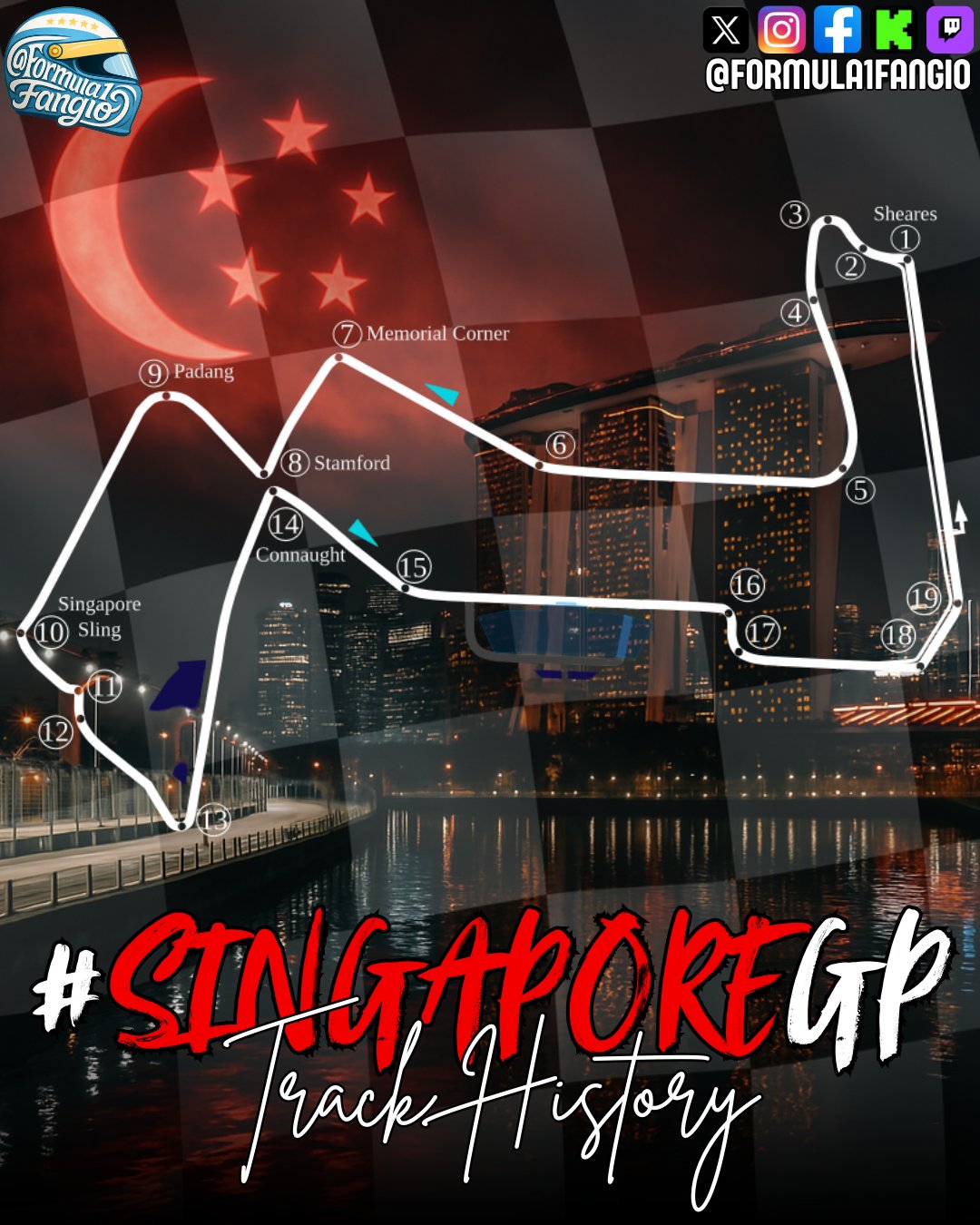
[Source](https://x.com/Formula1Fangio/status/1972760794644549735/photo/1)
Ese primer año las quejas se extendieron a otros factores: zonas de escape escasas y cortas, curvas mal diseñadas, baches en sectores sensibles del circuito y pianos mal asegurados fueron las principales observaciones. Con el correr de los años hubo mejoras, aunque las críticas continuaron; sin embargo, nada ha impedido que la fecha de Singapur continúe respetándose hasta el presente. Poderoso caballero es Don Dinero, diría mi abuela.
El circuito callejero de Singapur es un trazado urbano que se arma cada año en la zona de la bahía Marina Bay y tiene una longitud de 4,94 kilómetros aproximadamente. Al igual que otros circuitos callejeros, existen zonas peligrosamente angostas donde los muros no perdonan errores. Cuenta con 19 curvas y se gira en sentido contrario a las agujas del reloj.
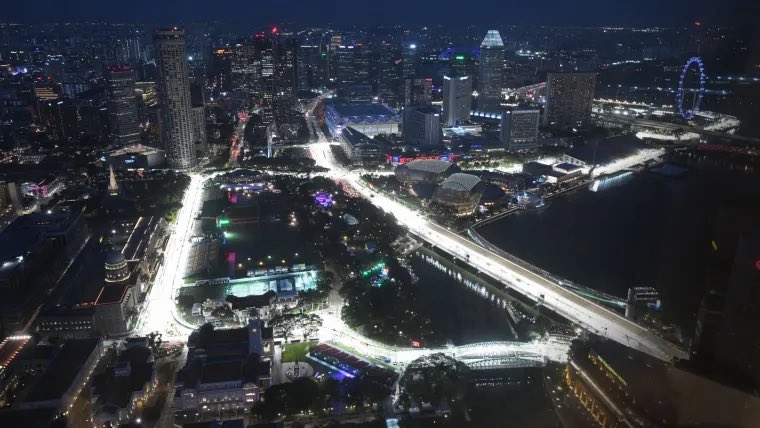
[Source](https://x.com/Dementor__/status/1972659131187184009/photo/1)
Al ser una carrera nocturna, la iluminación depende de miles de focos que dan una sensación única y desafiante, el asfalto con ciertos desniveles también es una característica que requiere alta concentración y un esfuerzo físico importante para los pilotos, si a ello le sumamos cierta rigurosidad climática provocada por la humedad y el calor estamos ante un gran premio difícil que exige concentración y destreza conductiva de primer nivel.
Marina Bay contaba con 3 zonas de DRS hasta la edición 2024, para este 2025 se ha agregado una cuarta zona para favorecer los adelantamientos; la primera zona se encuentra entre las curvas 5 y 7, la segunda está delimitada por las curvas 13 y 14, la recientemente agregada se ubica entre las curvas 14 y 16, la última es como habitualmente sucede sobre la recta principal. De esta manera pasa a ser el circuito con más sectores de DRS habilitados conjuntamente con el Albert Park de Melbourne. Otra modificación importante no tiene que ver con el trazado sino con la velocidad máxima en la calle de boxes que se redujo de 80 a 60 km, lo que agregará un mayor tiempo de detención para el cambio de cubiertas, algo no menor a considerar en las estrategias de carrera.
En 2023 se llevó adelante la última reforma eliminando el túnel y algunas tribunas, con lo cual el circuito se redujo a los 4,94 kilómetros de longitud actual.
El último ganador fue Lando Norris con McLaren y el año anterior la victoria quedó para Ferrari con la conducción de Carlos Sainz. Uno de los escasos accidentes destacables ocurrió en la edición de 2017, en aquella competencia una colisión en la primera vuelta que involucró a Sebastian Vettel, Kimi Räikkönen y Max Verstappen provocó que todos ellos quedaran eliminados, el incidente favoreció a Lewis Hamilton, quien triunfó en esa carrera.
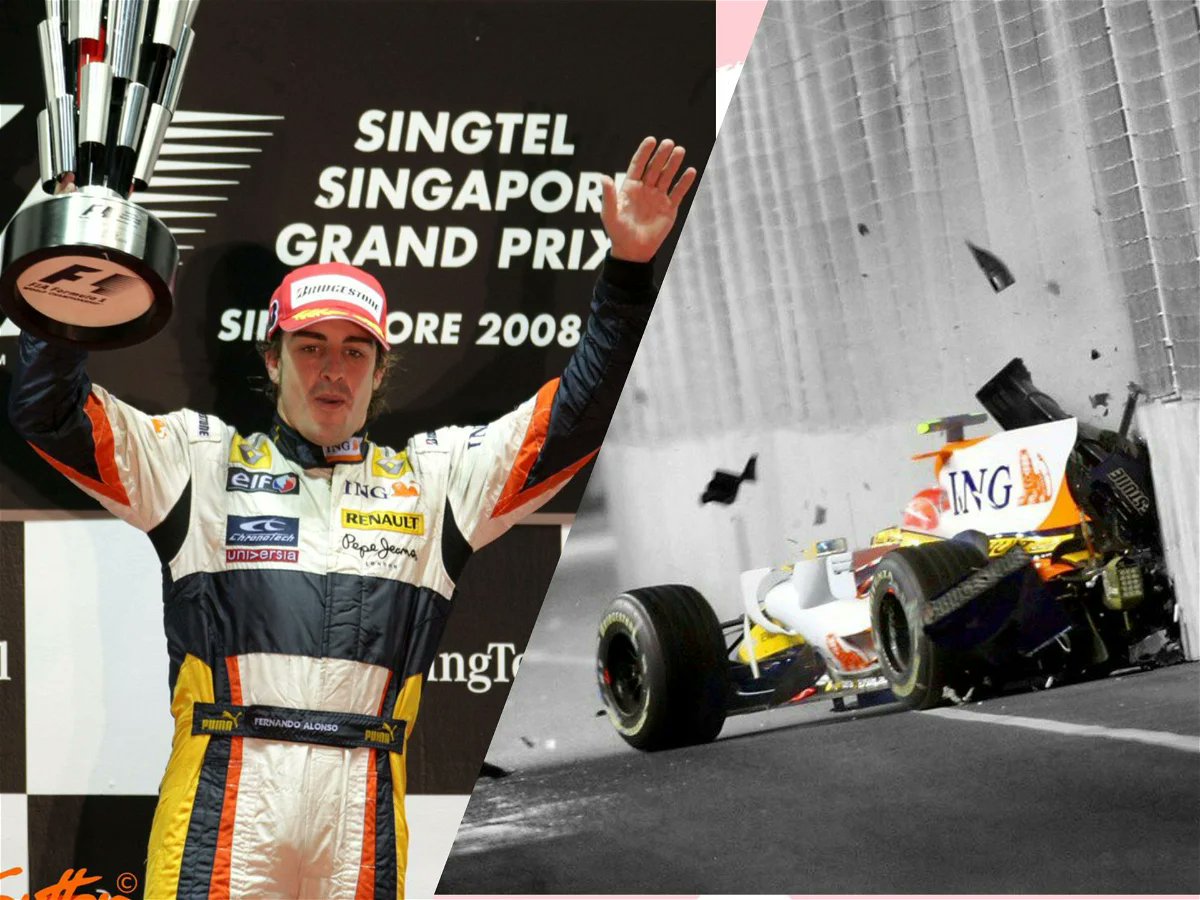
[Source](https://x.com/notracingpoint/status/1765112184760119485/photo/1)
En este circuito ocurrió en el año 2008 uno de los incidentes más polémicos de los últimos tiempos que fue conocido como "crashgate". Nelson Piquet Jr. colisionó voluntariamente su Renault siguiendo órdenes del equipo para lograr el ingreso del auto de seguridad y de esa manera favorecer a Fernando Alonso, que venía punteando la competencia y quien finalmente se quedó con la victoria. En las investigaciones posteriores se dictaminó la culpabilidad del equipo Renault, Flavio Briatore fue expulsado de cualquier evento relacionado con la Fórmula 1 de manera definitiva, y Pat Symonds, director deportivo en ese momento, recibió una sanción de cinco años. Piquet fue exonerado por haber colaborado con la investigación y Alonso fue exculpado por no haber tenido participación en el hecho. Años después, la pena a Briatore fue revocada por irregularidades en el proceso y es por ello que hoy lo tenemos nuevamente al frente del equipo Alpine. Historias que empañan en parte la grandeza de esta categoría.
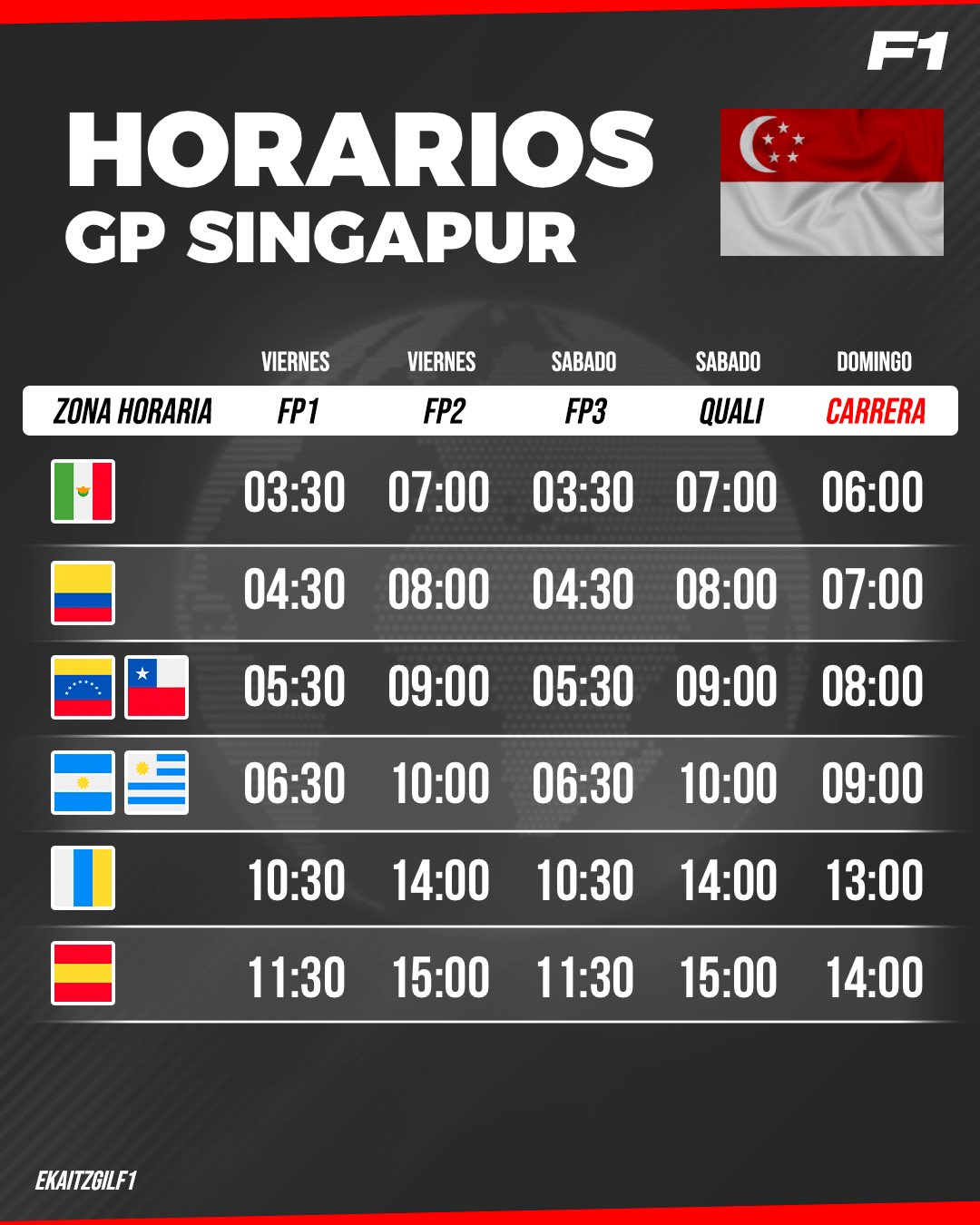
___________________________________________________________
_____________________________________________________
[Source](https://x.com/ekaitzgilf1/status/1972728315011268741/photo/1)
El Gran Premio Nocturno de Singapur puede tener sorpresas o convertirse en otra carrera aburrida y tediosa; dependerá de algunos factores que en los últimos tiempos se han negado tozudamente.
___________________________________________________________
#### Marina Bay Street Circuit
After a week off from the Azerbaijan event, Formula One action returns, this time at the young Marina Bay Street Circuit for the 18th round of the annual calendar, the Singapore Grand Prix.
I used the term "young circuit" because it simply means that. It was inaugurated in 2008, a relatively short time compared to the older, albeit renovated, circuits that represent the history and tradition of these competitions, having hosted the championships of this parent category of motorsports since their inception.
Since its inclusion in the annual calendar, the road for the Marina Bay Circuit has not been easy. The decision to run the race at night brought with it no small amount of controversy and disputes. Manufacturers and drivers raised major objections, citing safety concerns, although the FIA stood by its decision, and the night races began.
That first year, complaints extended to other factors: limited and short escape zones, poorly designed corners, potholes in sensitive sections of the circuit, and poorly secured kerbs were the main observations. Over the years, improvements were made, although criticism continued; however, nothing has prevented the Singapore date from continuing to be respected to this day. Money is a mighty knight, my grandmother would say.
The Singapore Street Circuit is an urban layout built annually in the Marina Bay area and is approximately 4.94 kilometers long. Like other street circuits, there are dangerously narrow sections where the walls are unforgiving. It has 19 corners and rotates counterclockwise.
Being a night race, the lighting relies on thousands of spotlights, creating a unique and challenging experience. The uneven asphalt also requires high concentration and significant physical effort from the drivers. Add to this the harsh climate caused by humidity and heat, and you're looking at a difficult Grand Prix that demands top-level concentration and driving skills.
Marina Bay had three DRS zones until the 2024 edition; for 2025, a fourth zone has been added to facilitate overtaking. The first zone is located between Turns 5 and 7; the second is delimited by Turns 13 and 14; the recently added zone is located between Turns 14 and 16; and the last zone is, as usual, on the main straight. This makes it the circuit with the most DRS zones enabled, along with Melbourne's Albert Park. Another important modification has nothing to do with the layout itself, but rather with the maximum speed on the pit lane, which was reduced from 80 to 60 km. This will add more stopping time for tire changes, something that should be considered in race strategies.
In 2023, the final renovation was carried out, eliminating the tunnel and some grandstands, reducing the circuit to its current length of 4.94 kilometers.
The last winner was Lando Norris with McLaren, and the previous year, Ferrari took victory with Carlos Sainz driving. One of the few notable accidents occurred in the 2017 edition. A collision on the first lap involving Sebastian Vettel, Kimi Raikkonen, and Max Verstappen resulted in the elimination of all of them. The incident favored Lewis Hamilton, who won that race.
One of the most controversial incidents of recent times, known as "crashgate," occurred at this circuit in 2008. Nelson Piquet Jr. intentionally crashed his Renault, following team orders, to allow the safety car to be deployed and thus favor Fernando Alonso, who had been leading the field and ultimately went on to win. The subsequent investigations ruled Renault's guilt, Flavio Briatore was permanently banned from all Formula 1 events, and Pat Symonds, the sporting director at the time, received a five-year ban. Piquet was exonerated for having collaborated with the investigation, and Alonso was cleared for having played no part in the incident. Years later, Briatore's sentence was overturned due to irregularities in the process, and that is why we have him back at the helm of the Alpine team today. Stories that somewhat tarnish the greatness of this category.
The Singapore Night Grand Prix could hold surprises or turn into another tedious race; it will depend on several factors that have stubbornly eluded us in recent times.
_____________________________________________________
Héctor Gugliermo
@hosgug
#spanish
#deportes
#dclub
#sports
#motores
#f1
#pob
#fun
#creativecoin
#neoxian
Payout: 18.892 HBD
Votes: 233
More interactions (upvote, reblog, reply) coming soon.